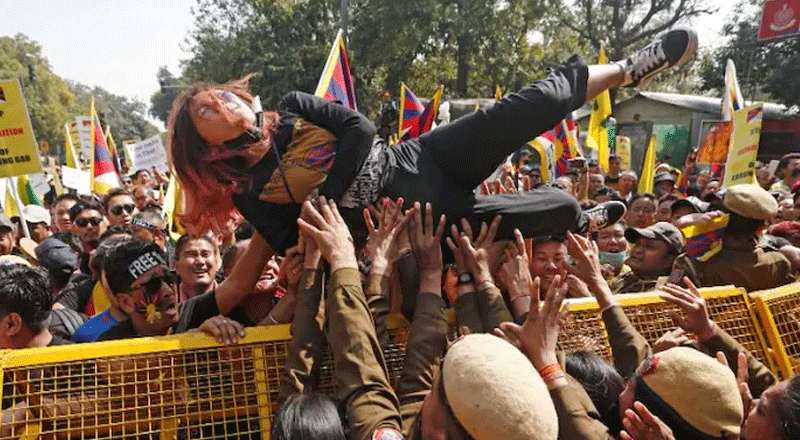Nepal’s aviation sector has faced a series of tragic incidents over the years, reflecting a deep-rooted problem in aviation safety. The recent crash of a Saurya Airlines plane at Tribhuvan International Airport (TIA) in Kathmandu has tragically brought this issue back into the spotlight. This crash, which resulted in the deaths of 17 passengers and left one survivor, is a stark reminder of the country’s ongoing aviation safety challenges. The incident is part of a broader pattern of serious aviation accidents in Nepal, which have claimed nearly 350 lives since 2000.
Recent Incident at Tribhuvan International Airport
On Wednesday morning, a Saurya Airlines plane, a Bombardier CRJ-200 regional jet, crashed while attempting to take off from Tribhuvan International Airport. The aircraft was carrying 19 individuals, including two crew members and 17 technicians, on a flight to Pokhara for maintenance checks. The crash occurred at 11:11 am local time. The plane burst into flames upon impact. Captain Manish Ratna Shakya, the sole survivor, sustained injuries, including damage to his eyes.
The Persistent Safety Issues in Nepal’s Aviation Industry
Nepal’s aviation safety record is marked by several persistent issues:
Challenging Terrain and Weather: Nepal’s mountainous landscape and unpredictable weather conditions pose significant challenges to aviation. The country’s rugged terrain makes it difficult to establish and maintain safe runways. The weather often changes rapidly, making flight operations particularly hazardous.
Infrastructure Deficiencies: Tribhuvan International Airport, situated in a valley surrounded by mountains, is known as one of the riskiest airports globally. Its single, bumpy runway and surrounding residential areas further complicate landing and takeoff procedures.
Aircraft Maintenance: Many aircraft used in Nepal are outdated. Regular maintenance is crucial, yet there have been numerous reports of inadequate upkeep, which contributes to the high accident rate.
Pilot Training: Operating in Nepal’s extreme conditions requires specialized training. However, the country faces challenges in providing comprehensive pilot training, adding to the safety risks.
Notable Aviation Accidents Since 2000
Nepal’s aviation history since 2000 is marked by several significant accidents:
- July 11, 2023: A helicopter crash in central Nepal resulted in six fatalities, including five Mexican nationals and a Nepali pilot. The helicopter had departed from Solukhumbu district, known for its high mountain peaks.
- January 15, 2023: A Yeti Airlines ATR 72 crashed in Pokhara, killing all 72 passengers. The accident, which was the deadliest since the 1992 Pakistan International Airlines crash, was caused by pilot error that led to an aerodynamic stall.
- May 29, 2022: A De Havilland Canada DHC-6-300 Twin Otter aircraft crashed 15 minutes after takeoff from Pokhara, killing 22 people, including 16 Nepalis, four Indians, and two Germans.
- February 27, 2019: A helicopter crashed in eastern Nepal in bad weather, killing all seven people on board, including the tourism minister.
- March 12, 2018: A US-Bangla Airlines plane crashed while landing at Kathmandu Airport, killing 51 people. The crash was attributed to poor weather conditions and pilot error.
- February 24, 2016: A Tara Air Twin Otter crashed in bad weather while en route from Pokhara to Jomsom, killing all 23 people on board.
- February 16, 2014: A Nepal Airlines Twin Otter went missing and was later found crashed, killing 13 of the 18 people aboard.
- September 28, 2012: A Dornier aircraft crashed shortly after take-off from Kathmandu, killing 19 people, including seven British and five Chinese passengers.
- September 25, 2011: A Buddha Air plane carrying tourists to view Mount Everest crashed near Kathmandu, killing all 19 people on board.
- December 16, 2010: A Tara Air Twin Otter crashed shortly after takeoff from Lamidanda to Kathmandu, killing 22 passengers and crew.
- August 24, 2010: A small plane operated by Agni Air crashed in bad weather, killing 14 people, including four Americans.
- October 8, 2008: A Twin Otter plane crashed in the remote mountains of northeast Nepal, killing at least 18 people, mostly foreigners.
- March 4, 2008: A helicopter crash in the Ramechhap district of eastern Nepal killed 10 people, including four UN arms monitors.
- June 21, 2006: A Yeti Airlines Twin Otter crashed minutes before landing in Taplejung, killing all nine people on board.
- May 25, 2004: A Twin Otter cargo plane operated by Yeti Airlines crashed in the Mount Everest region, killing its three crew members.
- August 22, 2002: A Shangrila Air Twin Otter crashed into a mountain in bad weather, killing all 18 people on board.
- July 17, 2002: A twin-engined aircraft crashed into a mountain in west Nepal, killing at least four people.
- July 27, 2000: A Royal Nepal Airlines Twin Otter crashed in Dadeldhura, killing all 25 passengers on board.
The Way Forward
The recent crash at Tribhuvan International Airport highlights the urgent need for improved aviation safety measures in Nepal. The airport has since reopened and flight operations have resumed, but the recurring safety issues underscore the necessity for comprehensive reforms. These include upgrading airport infrastructure, investing in modern aircraft, enhancing maintenance practices, and improving pilot training.
As Nepal continues to grapple with these challenges, addressing the fundamental issues in its aviation sector remains crucial for preventing future tragedies and ensuring the safety of passengers.
(With inputs from agencies)





